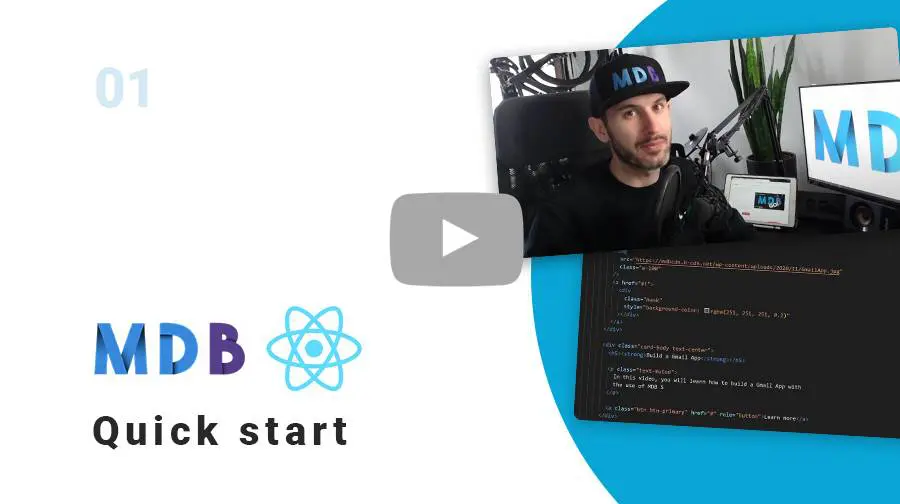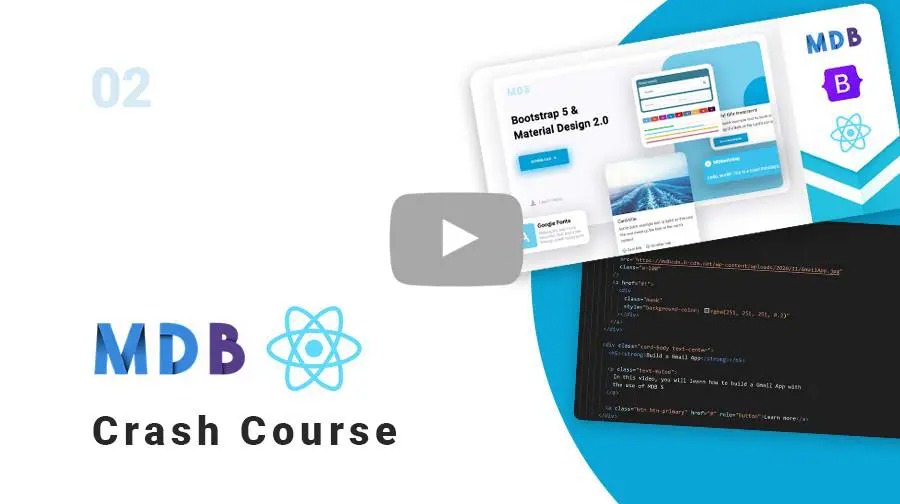Manual installation (zip package)
Step 1
Download the package
MDB REACT UI KIT downloadStep 2
Unzip downloaded package and open it in the code editor
Step 3
Install dependencies
npm install
Step 4
Run the application
npm start
Step 5
Explore our documentation (menu on the left). Choose components you like, copy it to your project and compose your website. And yes, it's that simple!
Note: Manual installation with a .zip package is the
easiest way, but many useful features are not available there.
To use the full potential of MDB and all available options, we recommend
installation through
MDB CLI.
Don't miss MDB React updates! Join our mailing list & receive information whenever a new update is released.
By subscribing you agree to receive the newsletter & commercial information from the data administrator StartupFlow s.c. Kijowska 7, Warsaw. Policy
MDB CLI
CLI installation is the most efficient way to use MDB. It enables options such as:
- Free hosting (supports custom domains, SSL, FTP access)
-
Install any MDB package
with a single command






- Easy updates with a single command
- Backend starter templates (Laravel, plain PHP, node.js & more)
- WordPress setup in 3 minutes (blog, ecommerce or blank project)
- Git repository for you and your team
GitHub
You can also download MDB REACT UI KIT directly from our GitHub.
If you like - please do not forget to support us with your star :)
MDB REACT UI KIT GitHubNPM
Prerequisites
Before starting the project make sure to install Node LTS (12.x.x or higher). We are using yarn to start a project.
If you want to use package from npm you have to have a project with React. We recommend creating an app with create-react-app from react for begginers.
Step 1
Create React App. We are using React 17+ version.
npx create-react-app my-app
Step 2
Navigate to app's directory
cd my-app
MDB installation
Step 1
Setup MDB
npm i mdb-react-ui-kit
CSS import
Add the following line in your index.js file before the App.js file import:
import 'mdb-react-ui-kit/dist/css/mdb.min.css'
Font Awesome
Add the following line in public/index.html file inside
head section:
<link href="https://use.fontawesome.com/releases/v5.15.1/css/all.css" rel="stylesheet" />
Roboto font
Add the following line in public/index.html file inside
head section:
<link href="https://fonts.googleapis.com/css?family=Roboto:300,400,500,700&display=swap" rel="stylesheet" />
Set font family in globally css file for example src/index.css inside
src folder as in the example:
body {
font-family: Roboto, Helvetica, Arial, sans-serif;
}
Step 2
Launch your app
npm start
Typescript implementation
We didn't put types for this library on DefinitelyTyped yet so if you want use mdb-react-ui-kit in your ts project you have to add a declaration module with types.
In our documentation, we use TypeScript syntax. You can have some warnings without it, but the code will always work as expected.
This instruction was tested with create-react-app with typescript template.. Below are showed dependencies used to test typescript implementation.
...
"dependencies": {
"@testing-library/jest-dom": "^5.11.4",
"@testing-library/react": "^11.1.0",
"@testing-library/user-event": "^12.1.10",
"@types/jest": "^26.0.15",
"@types/node": "^12.0.0",
"@types/react": "^16.9.53",
"@types/react-dom": "^16.9.8",
"react": "^17.0.1",
"react-dom": "^17.0.1",
"react-scripts": "4.0.1",
"typescript": "^4.0.3",
"web-vitals": "^0.2.4",
},
...
First, you have to create a new folder inside your project. You can create in the root directory.
mkdir typings
Inside the typings folder, you have to add a new folder with mdb-react-ui-kit name. After that you have to create new d.ts file inside mdb-react-ui-kit folder.
cd typings
mkdir mdb-react-ui-kit
cd mdb-react-ui-kit
touch index.d.ts
Inside new d.ts file you have to create a declaration module for mdb-react-ui-kit.
declaration module 'mdb-react-ui-kit'{
...
}
Now you have to add types declaration for this file. If you installed
mdb-react-ui-kit, you can find types inside
node_modules/mdb-react-ui-kit/dist/index.d.ts. You have to
copy everything to declaration module for mdb-react-ui-kit without
export {...}
at the bottom of the page.
In your tsconfig file in typeRoots option, you have to add
the path to mdb-react-ui-kit types.
{
"compilerOptions": {
...,
"typeRoots": ["./node_modules/@types", "./typings"]
},
}


